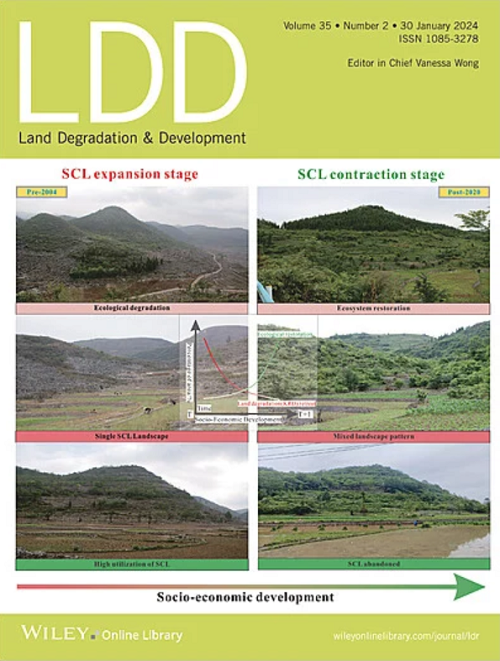基于光谱偏振特征和机器学习的干旱区干湿季节土壤盐渍化预测
IF 3.6
2区 农林科学
Q2 ENVIRONMENTAL SCIENCES
引用次数: 0
摘要
土壤盐渍化是干旱区土壤退化和生态系统退化的主要原因之一,对生态环境和农业安全构成严重威胁。了解影响土壤盐渍化的因素对土壤管理和改良具有重要意义。然而,干旱地区土壤盐渍化对季节变化的敏感性研究尚不深入。因此,本研究以焉焉焉焉焉焉焉焉焉焉焉焉焉焉焉焉焉焉焉焉焉焉焉焉焉焉焉焉焉焉焉焉焉焉焉焉焉焉焉焉焉焉焉焉焉焉焉焉焉焉焉焉焉焉焉焉焉焉焉焉焉焉焉焉焉焉非。利用Sentinel-1雷达遥感数据、Sentinel-2光学遥感数据和数字高程模型(DEM)提取土壤盐分特征变量。采用Boruta算法选择特征变量,并将最优特征变量与随机森林(Random Forest, RF)、支持向量机(Support Vector Machine, SVM)和极限梯度提升(Extreme Gradient boost, XGBoost)模型相结合构建预测模型。结果表明:(1)红边光谱特征(RE)能有效预测土壤盐渍化。此外,与ECe相关性最大的变量是高程(DEM)和河网基线(CNBL),这主要是因为研究区地形西北高东南低,中部农田平坦,水盐运动受地形影响显著。(2) RF模型是本研究中效果最好的预测模型,R2 = 0.78,能有效地反映旱季和湿季土壤盐分的空间分布。(3)雨季盐渍化程度显著高于旱季,主要受降水增加、植被覆盖减少、蒸发和盐分迁移的综合影响。(4)干湿季节,盐渍化土壤主要集中在博斯腾湖沿岸、开都河沿岸和湟水沟沿岸,轻度盐渍化土壤分布在戈壁沙漠地区。本研究为干旱区季节性变化引起的土壤盐渍化管理和治理提供了科学依据。本文章由计算机程序翻译,如有差异,请以英文原文为准。
Prediction of Soil Salinization in Arid Regions During Wet and Dry Seasons Based on Spectro-Polarimetric Features and Machine Learning
Soil salinization is one of the main causes of soil degradation and ecosystem deterioration in arid regions, posing a serious threat to ecological environments and agricultural security. Understanding the factors influencing soil salinization is crucial for soil management and improvement. However, the sensitivity of soil salinization to seasonal changes has not been thoroughly studied in arid regions. Therefore, this study focuses on the Yanqi Basin, where 129 soil samples were collected (wet season of 51, dry season of 78) for laboratory analysis to determine the soil saturated extract conductivity (ECe). Soil salinity feature variables were extracted from Sentinel-1 radar remote sensing data, Sentinel-2 optical remote sensing data, and digital elevation models (DEM). The Boruta algorithm was used to select feature variables, and the optimal feature variables were combined with Random Forest (RF), Support Vector Machine (SVM), and Extreme Gradient Boosting (XGBoost) models to construct prediction models. The results indicate: (1) Red-edge spectral features (RE) can effectively predict soil salinization. In addition, the variables most correlated with ECe are elevation (DEM) and river network baseline (CNBL), mainly because the terrain in the study area is higher in the northwest and lower in the southeast, with flat farmland in the central region, where the movement of water and salt is significantly influenced by the terrain. (2) The RF model is the best prediction model in this study, with R2 = 0.78, effectively revealing the spatial distribution of soil salinity during both the wet and dry seasons. (3) The degree of salinization in the wet season is significantly higher than in the dry season due to the combined effects of higher precipitation, lower vegetation cover, evaporation, and salt migration. (4) During both the dry and wet seasons, salinized soil is mainly concentrated along the shores of Bosten Lake, the Kaidu River, and Huangshui Ditch, while light salinization is distributed in the Gobi Desert areas. This study provides scientific evidence for the management and improvement of soil salinization caused by seasonal changes in arid regions.
求助全文
通过发布文献求助,成功后即可免费获取论文全文。
去求助
来源期刊

Land Degradation & Development
农林科学-环境科学
CiteScore
7.70
自引率
8.50%
发文量
379
审稿时长
5.5 months
期刊介绍:
Land Degradation & Development is an international journal which seeks to promote rational study of the recognition, monitoring, control and rehabilitation of degradation in terrestrial environments. The journal focuses on:
- what land degradation is;
- what causes land degradation;
- the impacts of land degradation
- the scale of land degradation;
- the history, current status or future trends of land degradation;
- avoidance, mitigation and control of land degradation;
- remedial actions to rehabilitate or restore degraded land;
- sustainable land management.
 求助内容:
求助内容: 应助结果提醒方式:
应助结果提醒方式:


